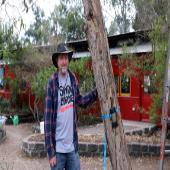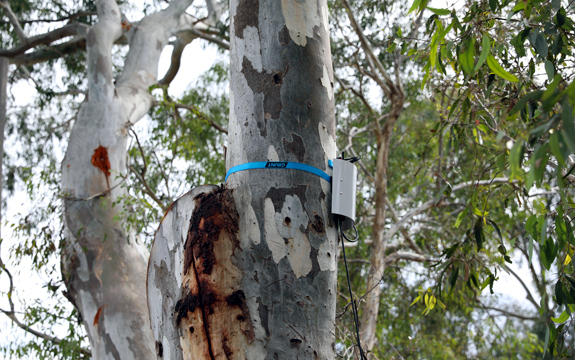Swinburne trials first smart urban forest management system

In Summary
- Swinburne, ICT International and RMIT University launch first urban forest management system
- Sensors installed at CERES collect real-time data on the trees’ ‘water use’ and ‘water stress’
- Communities can follow the trees’ real-time water-use and water-stress data via digital platforms
A new Swinburne-led pilot program introduced at CERES Community Environment Park is using water-sensor technology to better manage urban forests.
Swinburne Water Resources Engineering senior lecturer, Dr Scott Rayburg, and his team have partnered with ICT International and RMIT University to install $31,000 worth of tree water sensors at CERES, located in the Melbourne suburb of Brunswick East.
The sensors are an initiative designed to create healthier and more resilient urban forests where park managers and city residents can follow the progress of the trees via digital platforms that are informed by real-time water-use and water-stress data.
Dr Rayburg says it’s the first project of its type in the world.
“These sensors have previously been used in agriculture and plant biology, but never before in an urban forest management setting,” says Dr Rayburg.
“The project is transformational. Instead of trees dying at 80 years of age because they are spending their whole lives in water stress, they’ll live to be two or three or maybe even four hundred years old. That matters because when we lose a tree in an urban landscape we lose habitat, we lose cooling, we lose a part of ourselves, and people have a really visceral connection to trees.”
The project entails installing ‘water use’ and ‘water stress’ sensors on the trees to provide real-time watering data.
This data will also determine the most suitable species for current and future climates and allow urban forest managers to decide if, when and how much water to apply to their trees.
Talking trees
 The sensors in the instrumented trees at CERES provide constant, real-time watering data.
The sensors in the instrumented trees at CERES provide constant, real-time watering data.
After the installation of the sensors, Dr Rayburg and his team will design an app that allows people to ‘talk’ to trees and have the trees ‘talk’ back, engaging citizens in urban forest management.
Some local councils already provide datasets and updates on their urban forests, but the team is thinking bigger than this.
“The City of Melbourne has a platform called Urban Forest Visual that allows people to send an email to a tree and then somebody from the City of Melbourne responds to the email,” Dr Rayburg says. “This has been really popular, which demonstrates the desire people have to interact with nature, even in cities.”
“We want to take this to the next level; instead of a person responding, we want the tree to respond.”
The app will allow you to contact a tree and ask it how it’s going. It will collate the data being collected and send back an instant response, which might be “hey, I’m going great” or “I’m feeling a bit stressed today, could you please give me some water?”
Dr Rayburg hopes the app will engage citizens and take some of the pressure off councils being the only managers.
Spreading the word
CERES, a Centre for Education and Research in Environmental Strategies located in Brunswick East, currently has nine of the sensors instrumented across three tree species, including two Eucalypt varieties and Casuarinas. They are developing educational materials about the project in the hope of building up community interest and spreading the message.
“We want people to start talking about it. We should have these sensors in every urban forest in the world,” says Dr Rayburg.

